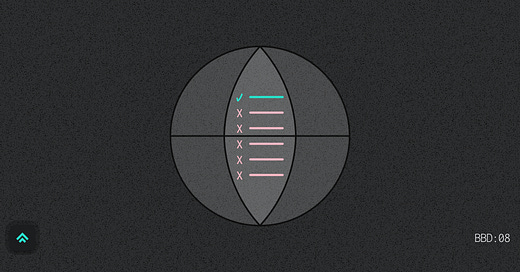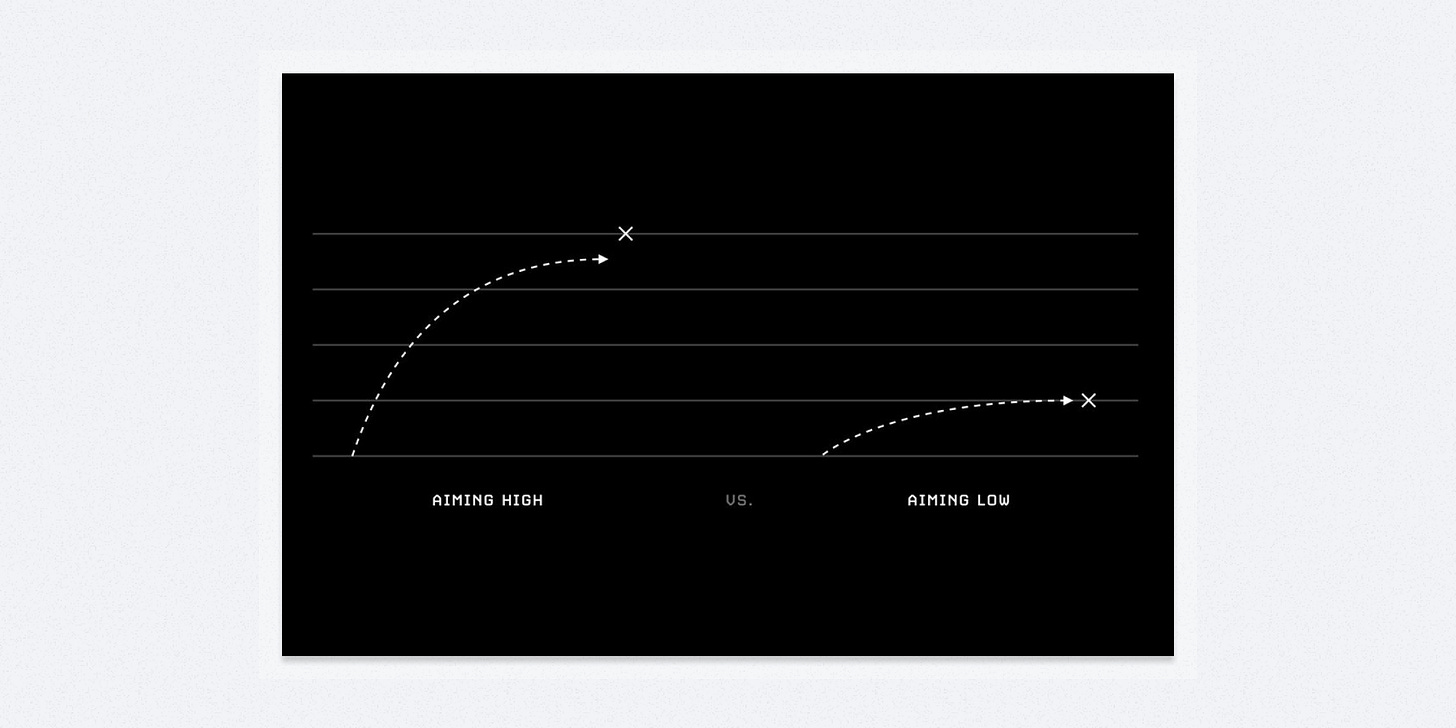Aim for "best in the world, bar none."
The importance of quality, craftsmanship, and aspiration for designing great products and finding your place in tech.
Good morning friends! 👋
Today I want to dive back into some higher-level philosophy.
Namely, some thoughts on the importance of quality, craftsmanship, and aspiration for designing great products and finding your place in tech.
Two things happened this week that got my philosophical wheels turning.
First, I gave a presentation at my company to reflect on how far we’ve come from a design perspective in the last year. There were many memes, a few bad jokes, and thankfully, lots of great progress to highlight! I closed my talk with a little segment called ‘Philosophy Corner’ (I can’t help myself 🤓), to hopefully inspire a renewed focus on making our product even better in the year to come.
Second, I purchased designer Jack Butcher’s Visualize Value course to start digging into his methods of visual design, branding, and communications. If you don’t know Jack’s work, his fingerprints are all over social media these days (at least mine). He has a gift for taking complex concepts and presenting them simply and visually. His work is quickly understandable and immediately recognizable.
It just so happens that the big concept I wanted to convey to my team also had entries in the Visualize Value cannon. So, I took that as a sign that I should double down and share with all of you too.
Quality all the way through
There’s a passage in Walter Isaacson’s biography of Steve Jobs that I’ll never forget.
[Jobs] said that his father refused to use poor wood for the back of cabinets, or to build a fence that wasn’t constructed as well on the back side as it was the front. [He] likened it to using a piece of plywood on the back of a beautiful chest of drawers.
“For you to sleep well at night, the aesthetic, the quality, has to be carried all the way through.”
To me, what Jobs was getting at in the memory of his father was the ideal of craftsmanship. Pursuing the highest level of craftsmanship requires you to care deeply about the quality of the work, regardless of whether or not it’s visible or celebrated.
In my craft as a designer, I think a lot about quality. Way more than the average person and probably quite a bit more than many other folks who hold product-oriented roles in tech. I don’t just think about it, I obsess over it. It drives not only my work-life but my personal creative pursuits and even the products I consider buying for myself.
I shared the passage from Jobs’ biography with my team because I wanted to convey that good design doesn’t stop at the interface.
The interface is just the surface level. Sure, it’s often the most visible piece of a software product and it’s the piece that’s routinely touched by a person with ‘design’ in their job title. But nonetheless, it’s just one piece of what goes into delivering a world-class software experience.
The pursuit of quality must be a collective effort for any team to ship great software. And that quality must carry all the way through. From the top of the stack all the way down to the most invisible foundations.
“Bar None”
Spending that time thinking about quality got me reminiscing about the start of my career as a brand strategist at famed ad agency Leo Burnett.
I don’t know now if it was a direct quote from Leo himself or just a saying that had seeped into the company culture, but the agency’s mantra for making creative work was to make it “the best in the world, bar none.”
It’s a simple and wildly ambitious statement. The kind of slogan that gets stuck in your head. The kind you might expect to see from a talented copywriter like Mr. Burnett himself.
Like Jobs, Burnett was a stickler for quality. He even “occasionally scrapped an advertising campaign that had been accepted by a client because he was not satisfied with its quality.”
I don’t remember thinking that much about this mantra while I was working at the agency. It was omnipresent, but I was too in over my head adjusting to the basics of work-life to spend much time considering such aspiration. A decade later, I consider it a real blessing to have introduced myself to the working world in a place with such creative ambition.
While a career in advertising was not for me, the business of creativity most certainly was. And though I fall short time after time, I’ll never stop striving for work that’s “the best in the world, bar none.”
Which brings me to Jack Butcher’s visualizations.
First up: the importance of aiming high.
Achieving great creative work is hard and it’s easy to cop out.
My best creative outputs might end up feeling “easy” only because I managed to grind through the many moments of blood, sweat, and tears to finally unlock that fleeting moment of flow.
So why do I keep showing up?
Because my aim, my aspiration, and my dream, are significant enough to motivate me to suck it up and hunker down in those tough moments.
As Steven Pressfield would say: you will face Resistance. From yourself and others.
It’s not your fault. And it’s not theirs. It’s just reality.
So as you think about your aspiration as a designer, engineer, or any creative profession, aim high. Higher than feels comfortable. Like maybe “best in the world” high. You might miss that mark, but the trajectory you put yourself on will propel you much higher than if you had only set your sights on a lower, more broadly acceptable mark.
Now you might wonder: how can I become the “best in the world” in the digital creative era? Butcher’s visual above captures some additional guidance from AngelList founder Naval Ravikant:
“Become the best in the world at what you do. Keep redefining what you do until this is true.”
In the weird, evolving technological disciplines we’re working in you become the best through experimentation and redefinition.
The market is huge, amorphous, and fluid.
We’re not aiming for victory in a narrowly defined event like an Olympic sport.
We’re aiming to find or create a unique, symbiotic space for ourselves in the ever-evolving digital ecosystem.
I want to leave you with my simple, personal reflection process that I shared on the JupiterOne engineering team’s YouTube show last week.
At each stop of my working life, I’ve asked myself these two questions:
“What do I like most about what I’m doing and how can I do more of it?”
“What do I like least about what I’m doing and how can I do less of it?”
After taking stock of how I feel in both of those areas, I make an educated guess about what I might do next that could tilt the scales in the favor of doing more that I like and less that I don’t.
It’s the continual redefinition that took me from advertising to programming, to design. And while I don’t yet know where that process will take me next, I can assure you I won’t stop redefining until “the best in the world, bar none” is true.
I hope you won’t either.
Have a great week.
Live long and design systems 🖖,
Pat
Similar posts
If you got a little value in this post, consider subscribing, sharing or following me on Twitter. If you got a lot of value I’d appreciate it if you bought me a coffee 😎☕️.










